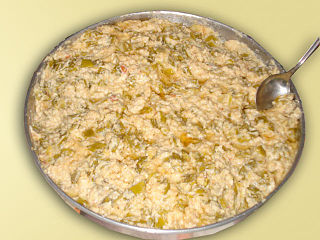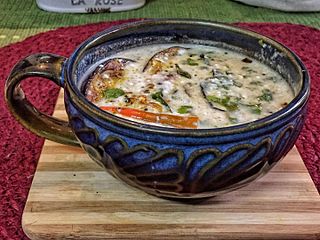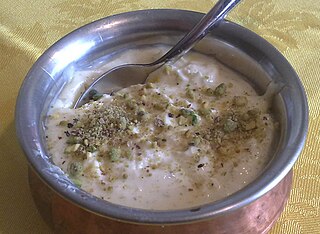 W
WThis is a list of yogurt-based dishes and beverages. Yogurt is a food produced by bacterial fermentation of milk. The bacteria used to make yogurt are known as "yogurt cultures". Fermentation of lactose by these bacteria produces lactic acid, which acts on milk protein to give yogurt its texture and its characteristic tang. Worldwide, cow's milk, the protein of which is mainly casein, is most commonly used to make yogurt. Milk from water buffalo, goats, ewes, mares, camels, and yaks is also used to produce yogurt in various parts of the world.
 W
WBorani is an Iranian appetizer made with yogurt, spinach and other ingredients. It is also common in Persian Jewish cuisine. Some provinces of Turkey, like Isparta and Van also have borani in their cuisines. Borani is also popular in the Caucasus.
 W
WÇılbır is a Turkish dish of poached eggs with yogurt.
 W
WDahi baigana is an Odia dish prepared from dahi (yogurt) and eggplant especially during festivals. This dish can be prepared without using onion and garlic when they are not allowed in some auspicious festivals.
 W
WDahi chutney is strained dahi that is mixed into a chutney of mint and onions, originating from the Indian subcontinent. It is popular in South India and is a side dish for the popular Hyderabadi biryani.
 W
WDahipuri, or dahi puri, is a snack, originating from India, which is especially popular in the state of Maharashtra, India. The dish is a form of chaat and originates from the city of Mumbai. It is served with mini-puri shells (golgappa), which are more popularly recognized from the dish pani puri. Dahi puri and pani puri chaats are often sold from the same vendor.
 W
WDahi vada is a type of chaat (snack) originating from the Indian subcontinent and popular throughout South Asia. It is prepared by soaking vadas in thick dahi (yogurt).
 W
WDahibara Aludam is a variant of Dahi vada and originated from Cuttack of the state Odisha. It is a type of chaat (snack) from Cuttack and is popular throughout India. The dish is prepared by soaking vadas in light dahi (yogurt) water. Then adding Aloo Dam and guguni to it.
 W
WDovga is a national meal of Azerbaijani cuisine, a soup traditionally made from plain yoghurt and herbs.
 W
WJameed is a Beduin-Jordanian food consisting of hard dry laban made from ewe or goat's milk. Milk is kept in a fine woven cheesecloth to make a thick yogurt. Salt is added daily to thicken the yogurt even more and the outside of the yogurt-filled cheesecloth is rinsed with water to allow any remaining whey to seep through. After a few days of salting the yogurt, it becomes very dense and can be removed from the cheesecloth and shaped into round balls. It is then set to dry for a few days. If it is dried in the sun it becomes yellow; if it is dried in the shade it remains white. It is important that the jameed is dry to the core because any dampness can spoil the preservation process. Jameed is the primary ingredient used to make mansaf, the national dish of Jordan.
 W
WKadhi or karhi is a dish originating from the Indian subcontinent. It consists of a thick gravy based on gram flour, and contains vegetable fritters called pakoras, to which dahi (yogurt) is added to give it a bit of sour taste. It is often eaten with boiled rice or roti.
 W
WKashk is a range of dairy products used in cuisines of Iranian, Afghan, Turkish, Mongolian, Central Asian, Transcaucasian and the Levantine people. Kashk is made from drained yogurt or drained sour milk by forming it and letting it dry. It can be made in a variety of forms, including rolled into balls, sliced into strips, and formed into chunks.
 W
WMishti doi is a fermented sweet doi (yogurt) originating from Bogra District in Bangladesh and a very popular dessert throughout the country. It is also popular in the Indian states of West Bengal, Tripura and Assam's Barak Valley. It is made with milk and sugar/jaggery. It differs from the plain yogurt because of the technique of preparation.
 W
WPapri chat or papri chaat is a popular traditional fast food and street food from the Indian subcontinent, probably in North India, Bangladesh and Pakistan. Many various additional dishes throughout India are also referred to as papri chat. Some restaurants in the United States serve the traditional version of the dish.
 W
WParfait describes two types of dessert. In France, where the dish originated, parfait is made by boiling cream, egg, sugar and syrup to create a custard-like puree which is sometimes served in a parfait glass. The American version includes more ingredients like granola, nuts, yogurt and liqueurs made in combination with a topping of fruits or whipped cream that are layered and served in a tall glass. The oldest known recipe dates back to 1892.
 W
WPasanda is a popular meat dish from the Indian subcontinent, notably North Indian, Hyderabadi and Pakistani, derived from a meal served in the court of the Mughal emperors. The word is a variation on the Urdu word "pasande" meaning "favourite", which refers to the prime cut of meat traditionally used within.
 W
WRiti raita is a condiment in South Asian cuisine made of dahi together with raw or cooked vegetables, more seldom fruit, or in the case of boondi raita, with fried droplets of batter made from besan.
 W
WShrikhand is an Indian sweet dish made of strained dahi (yogurt).
 W
WSpas is a yoghurt-based soup. It is a traditional dish in Armenia. It can be served hot or cold. Besides yoghurt, the main ingredient is hulled wheat, or rice.
 W
WTzatziki, cacık or tarator is a dip, soup, or sauce found in the cuisines of Southeast Europe and the Middle East. It is made of salted strained yogurt or diluted yogurt mixed with cucumbers, garlic, salt, olive oil, sometimes with vinegar or lemon juice, and herbs such as dill, mint, parsley and thyme. It is generally served as a cold appetizer (meze) or a side dish.